

Representation of Adolescent Identity Status through Facebook Use. You Don’t Know Me: Adolescent Identity Development Through Poetry Performance. You Don’t Know Me: Adolescent Identity Development Through Poetry Writing Janette Michelle Hughes and Laura Jane Morrison University of Ontario Institute of Technology Cornelia Hoogland University of Western Ontario Modern adolescents exist in a technology-saturated world.

Using a mixed-methods research approach of qualitative case study analysis, quantitative surveying, Vox Autobiographia, research-voiced poems, and Vox Participare, participant voiced poems, this research investigates the relationship between a multiliteracies pedagogy, poetic inquiry, and the development of adolescent identity. 1. 2. Selfidentity. Notes for Emotional Development, the Self and Identity School of Family and Consumer Sciences 400.404/504 Instructor: D.
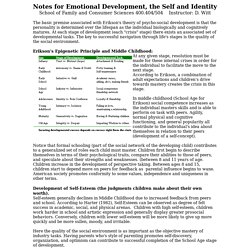
Witt The basic premise associated with Erikson's theory of psycho-social development is that the personality is determined over the lifespan as the individual biologically and cognitively matures. At each stage of development (each "crisis" stage) there exists an associated set of developmental tasks. The key to successful navigation through life's stages is the quality of the social environment. Erikson's Epigenetic Principle and Middle Childhood: At any given stage, resolution must be made for these internal crises in order for the individual to facilitate the move to the next stage. In middle childhood (School Age for Erikson) social competence increases as the individual masters skills and is able to perform on task with peers. Lesson Plan: Identity: Defining Self, Choosing Friends. Download the Lesson Plan Jump to: In this lesson, students explore the factors that influence self-identity, which frequently evolves as adolescents negotiate life’s circumstances to find and secure their places in the world.
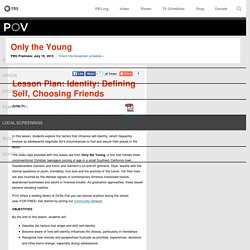
The video clips provided with this lesson are from Only the Young, a film that follows three unconventional Christian teenagers coming of age in a small Southern California town. Skateboarders Garrison and Kevin and Garrison’s on-and-off girlfriend, Skye, wrestle with the eternal questions of youth: friendship, true love and the promise of the future. Yet their lives are also touched by the distress signals of contemporary America–foreclosed homes, abandoned businesses and adults in financial trouble. POV offers a lending library of DVDs that you can borrow anytime during the school year–FOR FREE! Untitled. Untitled. The Sociocultural Approach in Psychology - Cognitive Psychology - Psychologist World. Untitled. Untitled. Untitled. Factors Influencing Identity Formation. Adolescence, Identity and Spirituality. A number of years ago I overheard my then teenage son discussing with his friends the origin of AIDS.
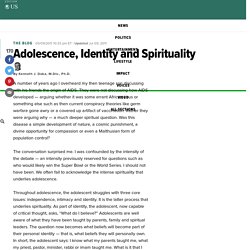
They were not discussing how AIDS developed — arguing whether it was some errant African virus or something else such as then current conspiracy theories like germ warfare gone awry or a covered up artifact of vaccination. Rather they were arguing why — a much deeper spiritual question. Was this disease a simple development of nature, a cosmic punishment, a divine opportunity for compassion or even a Malthusian form of population control? The conversation surprised me. I was confounded by the intensity of the debate — an intensity previously reserved for questions such as who would likely win the Super Bowl or the World Series. Throughout adolescence, the adolescent struggles with three core issues: independence, intimacy and identity.
Moreover, as adolescents begin to develop critical thinking, they are encountering their own spiritual questions. Kenneth J. Your Teen’s Search for Identity. Their bodies kick into overdrive.

They find themselves disoriented, scared and alone. They become moody, secretive and sarcastic. You don’t recognize your own child. What happened to the child you used to know? The answer: adolescence. In the teenage years, young people begin their quests for identity. Through status symbols. Offering Help to Your Teen Establishing an identity is not an easy process. Draw a set of three concentric circles. Identity Formation in Adolescence. A publication of the ACT for Youth Center of Excellence The question, "Who am I?
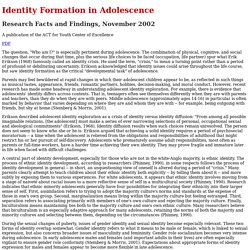
" is especially pertinent during adolescence. The combination of physical, cognitive, and social changes that occur during that time, plus the serious life choices to be faced (occupation, life partner) spur what Erik Erikson (1968) famously called an identity crisis. He used the term, "crisis," to mean a turning point rather than a period of profound or debilitating uncertainty.
Erikson acknowledged that identity issues could arise throughout the life course, but saw identity formation as the critical "developmental task" of adolescence. Parents may feel bewildered at rapid changes in which their adolescent children appear to be, as reflected in such things as musical tastes, appearance, friends, romantic partners, hobbies, decision-making, and moral conduct. ACT for Youth - Adolescence - Adolescent Identity Development.
The development of a strong and stable sense of self is widely considered to be one of the central tasks of adolescence [1].
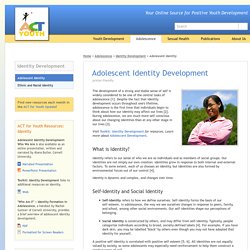
Despite the fact that identity development occurs throughout one's lifetime, adolescence is the first time that individuals begin to think about how our identity may affect our lives [2]. During adolescence, we are much more self-conscious about our changing identities than at any other stage in our lives [3]. Visit Toolkit: Identity Development for resources. Learn more about Adolescent Development. What is Identity?
Identity refers to our sense of who we are as individuals and as members of social groups. Identity is dynamic and complex, and changes over time.